KitchenAid vs. Bosch {Which Mixer Do You Really Need?}
It’s KitchenAid vs. Bosch! In this ultimate showdown between two of the most popular stand mixers on the market, learn the ins and outs of each mixer, and find out which stand mixer is right for you!
Disclaimer: this is an unsponsored post (i.e. I haven’t been paid to talk about these mixers); this post contains a few affiliate links which means that, at no additional cost to you, I may earn a small commission if you make a purchase. Thanks so much for your support in this way!. As always, feel free to shop around for the best price!
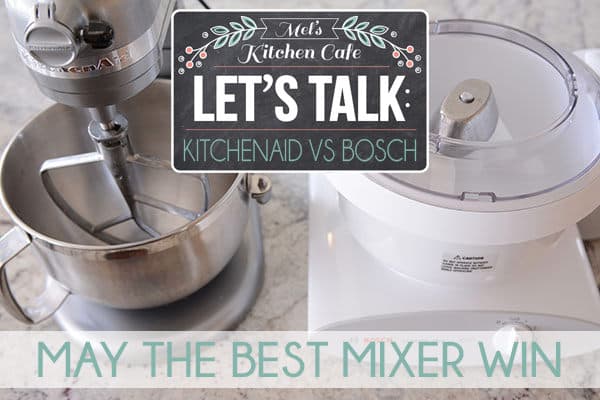
In my extremely scientific (read: not scientific at all) research analysis, I’ve found that out of all my readers that own a stand mixer, most of you have either a KitchenAid or a Bosch mixer.
There are other brands on the market, but today, I want to focus on these two mixers.
It’s a battle of KitchenAid vs. Bosch!
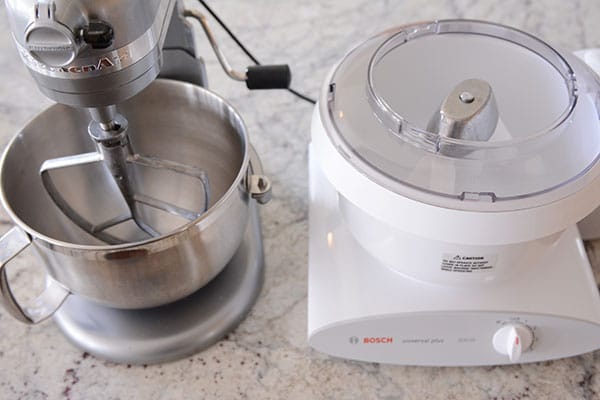
My Experience Using Both Mixers
They are vastly different mixers. You can see this immediately in terms of shape, color, size, and design.
And because of that, each have good points…and some not so good points.
I’ve been a loyal Bosch Universal fan for years. I received one in the first years of my marriage and have been using it since (not the original mixer – I gave that one to a friend when I upgraded to the new model design a couple of years ago, but the 14-year old Bosch is going strong for my pal, Katie).
As for using a KitchenAid, many years ago, Costco was running a huge rebate on KitchenAid mixers, and I took the plunge and snagged one during the sale.
I never thought I would be a KitchenAid owner (or fan), but after hearing several friends rave about their KitchenAid’s strengths, I decided I wanted to try one out for myself.
She’s definitely a beauty, no doubt about that.
In all honesty, I was tempted to return the KitchenAid mixer within the first few weeks I had it (mostly because it felt, and still feels sometimes, excessive to have two stand mixers), but I stuck out the learning curve of a new mixer, and I’m glad I did, because it’s given me time to figure out which mixer really is the best.
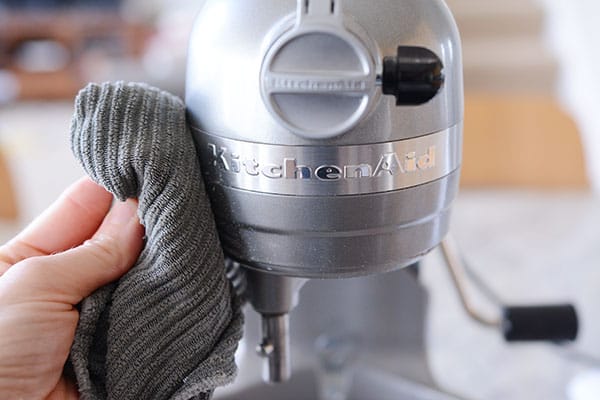
Comparing KitchenAid to Bosch Universal
The KitchenAid I bought at Costco is unique to Costco stores and is a bit different than KitchenAid mixers you can buy online or at other stores, but it is very similar to this KitchenAid mixer.
This is the Bosch Universal mixer I have.
The Bosch stand mixer is also offered in a compact version (400 watts, 4-quart bowl capacity, about $189). And the KitchenAid mixers come in many different variations of motor power and bowl capacity (such as this 5-quart, 325 watt mixer, about $299).
For the purpose of today’s KitchenAid vs. Bosch post, I want to compare similar models between brands (so that it wouldn’t be an unfair contest, like comparing a Ferrari to a Nissan Sentra).
Below, you can see some of the basic specs for each of the mixers.
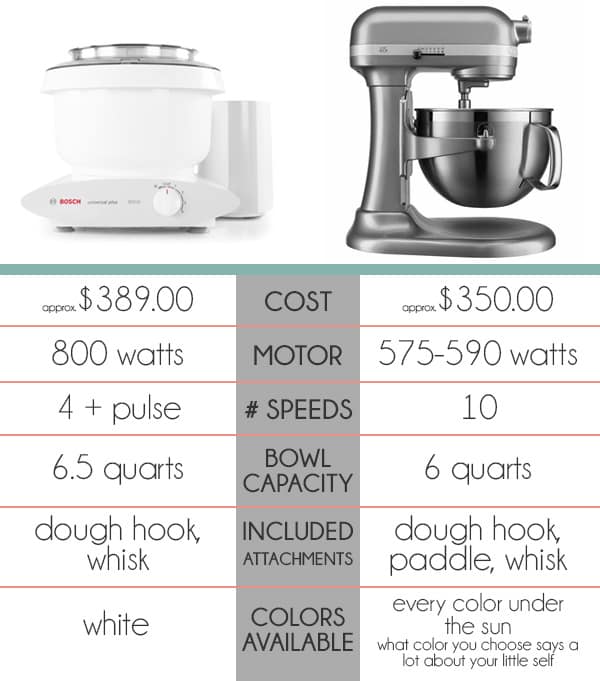
Fairly similar in price and bowl capacity, the Bosch shines in it’s higher powered motor at 800 watts (and let’s be serious, the KitchenAid can’t be beat when it comes to color options).
This makes a big difference when it comes to making things like bread. If I had a dollar for every time I heard that someone’s KitchenAid mixer burned up making bread…
It seems to be a common issue with KitchenAid mixers, although less so with higher powered KitchenAid’s (500 watts and above).
However, I have never heard anyone say their Bosch mixer motor burned out, especially not while making bread, which brings me to my first comparison point.
The Bosch Shines at Bread-Making
The Bosch Universal is hands down the best mixer for making bread.
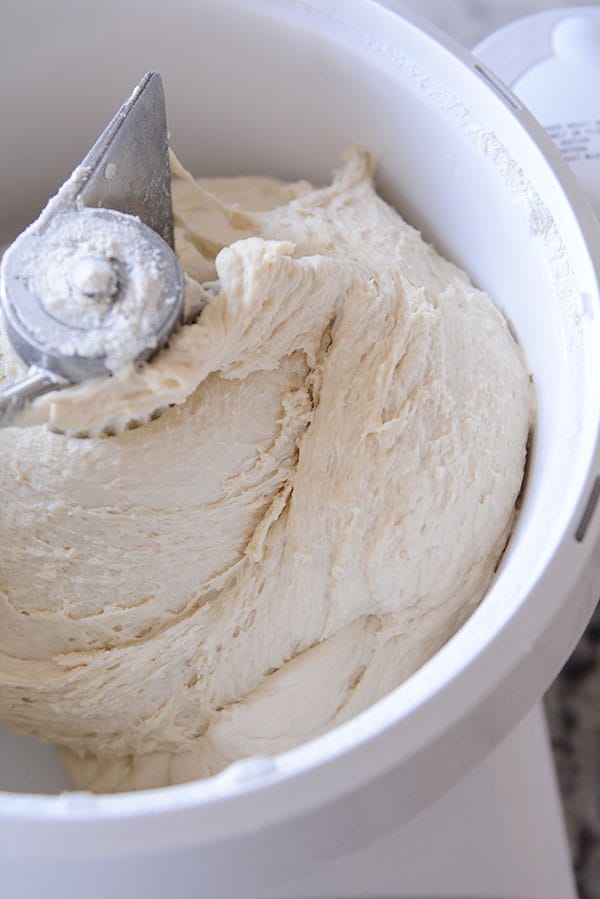
Because of the bowl design (the mixing shaft comes up from the bottom rather than the top, like the KitchenAid), and because of the higher power, the Bosch can easily hold upwards of 22 cups of ingredients in the bowl and will mix bread like a boss.
I always make large batches of bread in my Bosch, including my go-to whole wheat bread recipe that makes 5-6 loaves.
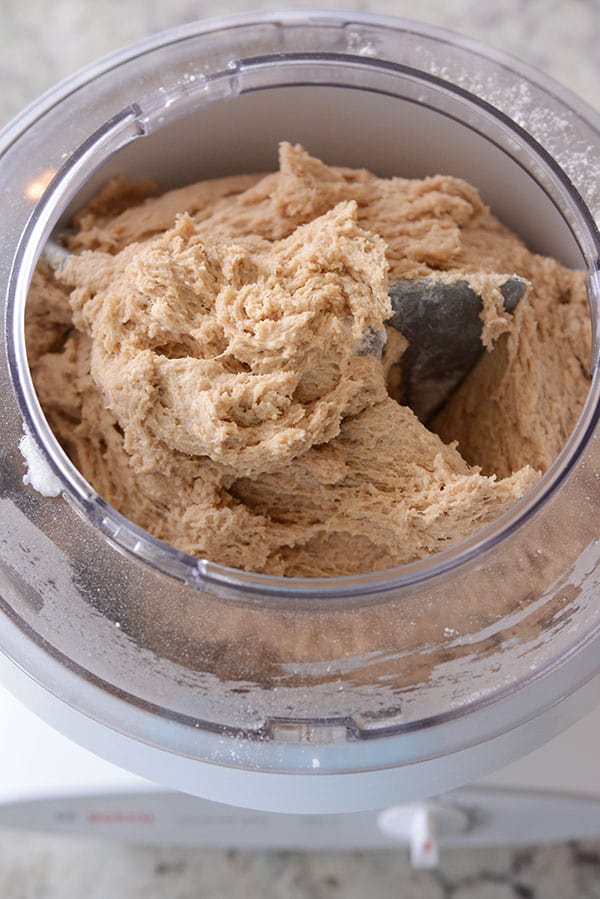
I think the Bosch handles small batches of dough just fine, also, although I will say that this is a common complaint with the Bosch: small batches of anything don’t fare well.
The secret I’ve learned is to add the flour very gradually for small batches of bread in the Bosch, otherwise, you’re left with dry patches as the dough just spins aimlessly in the mixer unable to incorporate all the ingredients.
The KitchenAid and Bread-Making
Now let’s talk about the KitchenAid and bread.
I have turned to my KitchenAid a time or two to make smaller batches of bread (like these divine breadsticks).
It works fine, but I find it’s much easier to overflour the dough in the KitchenAid in order to get all the ingredients mixed based on how the dough hook moves around the bowl.
Making large batches of bread dough is out when it comes to the KitchenAid, in my opinion, but small batches seem to work ok. I’ve found I often have to scrape the sides of the bowl down to help incorporate flour – a difference between KitchenAid and Bosch as I never have to scrape down the sides of the Bosch bowl when making bread.
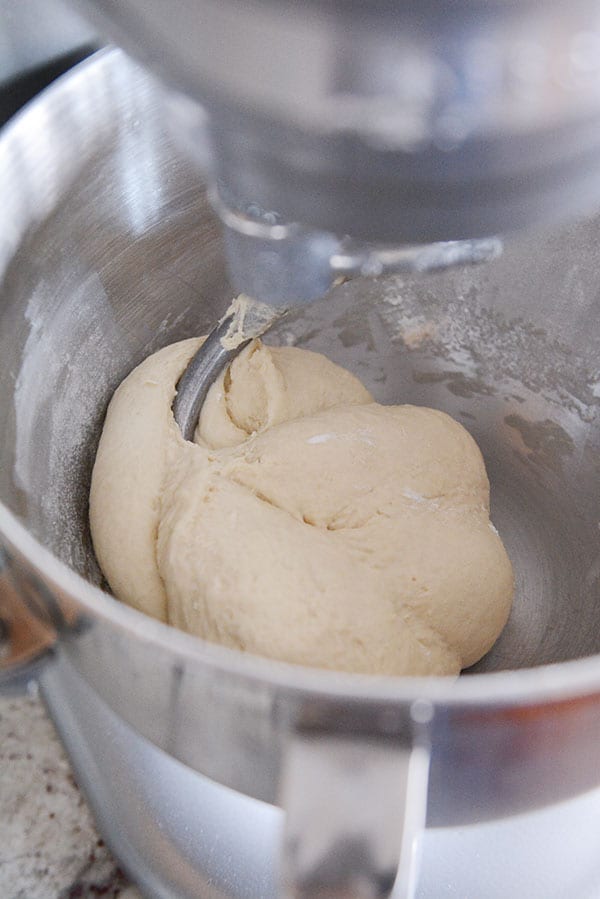
I’m going to detail a few more side-by-side comparisons below, but if you want to jump right to an overview, here’s a little chart for an at-a-glance picture at how these mixers measure up against each other.
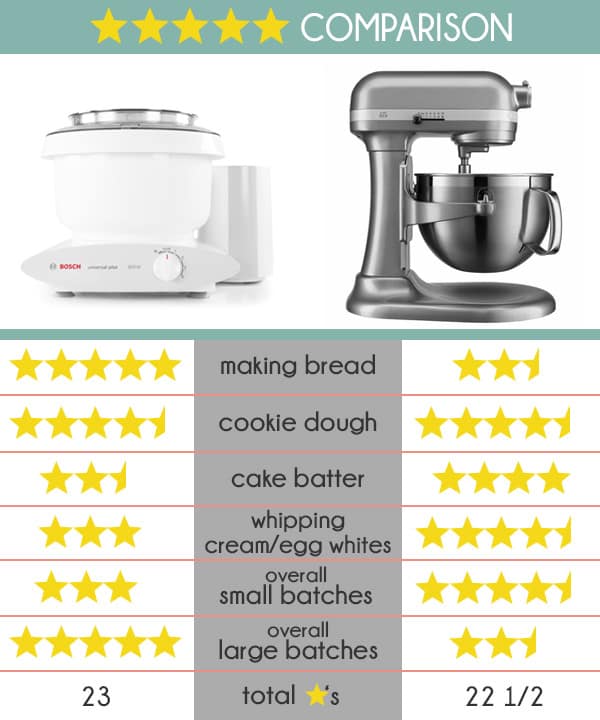
Cookie Making in a KitchenAid and Bosch Universal
Both the Bosch and the KitchenAid are awesome for cookie making.
I made the exact same chocolate chip cookie recipe side-by-side in each mixer.
You can see that initially, the Bosch does a slightly better job at incorporating the butter and sugar together. The butter doesn’t get as hung up on the cookie paddles in the Bosch like it does in the KitchenAid.
As a sidenote, the cookie paddles are not included with the Bosch mixer, but are totally worth the extra $20 purchase; I use the dough hook or cookie paddles for everything I make in the Bosch.
UPDATE: I’ve started using the cookie paddles to cream the soft ingredients and then switch to the dough hook when adding the dry ingredients (I had a couple sets of cookie paddles break on me). And often, I just use the dough hook start to finish.
This dough hook that is sold separately is a game changer for the Bosch – it helps with dough climbing up the center column and overall just does a better job mixing any and all ingredients. I wish this was the dough hook shipped with the Bosch!
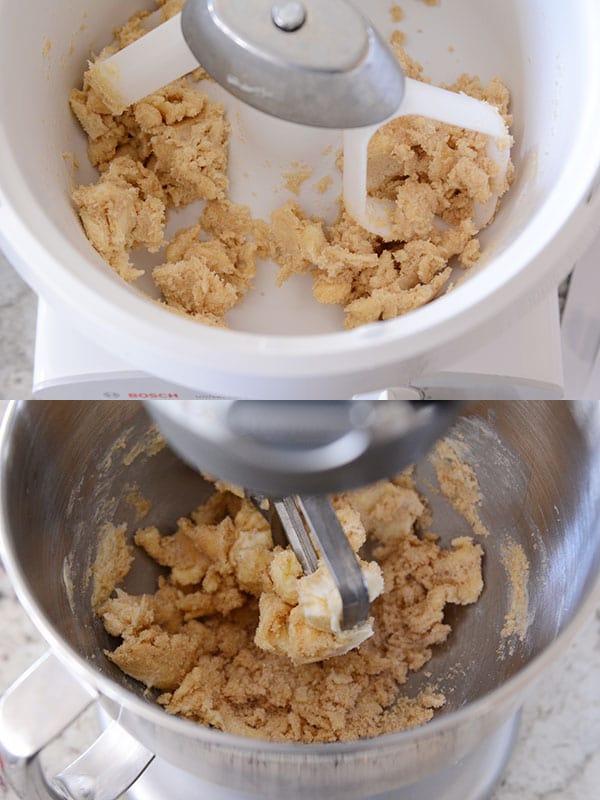
After a little pause for scraping the butter off the paddle, the KitchenAid works great.
Interestingly both mixers struggled a bit to incorporate the eggs into the cookie dough without some excessive scraping action, as well.
Which brings me to a pretty major point that BOTH mixers have issues with ingredients getting stuck to the bottom of the bowl, especially with wet batters or doughs, and based on design (and even after manipulating the screw on the KitchenAid to bring the paddle closer to the bottom of the bowl), it requires some scraping to get everything incorporated.
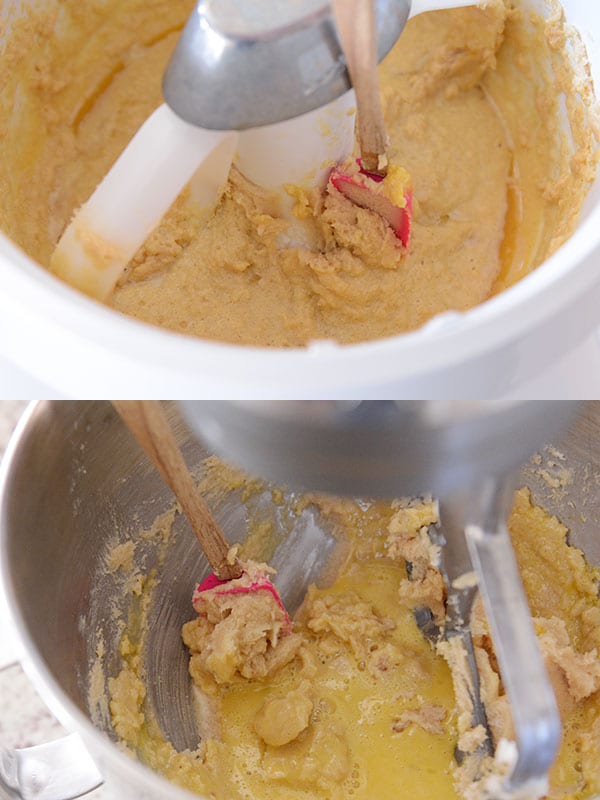
This is NOT an issue when doubling a standard cookie dough recipe in the Bosch, FYI (beautiful double batch of cookie dough pictured just below).
The larger quantities of everything seem to help the paddles pick up all necessary bits, but doing the same and doubling a cookie dough recipe in the KitchenAid, I still had to dig in there to scrape lingering bits of butter and sugar off the bottom (but not necessarily the sides).
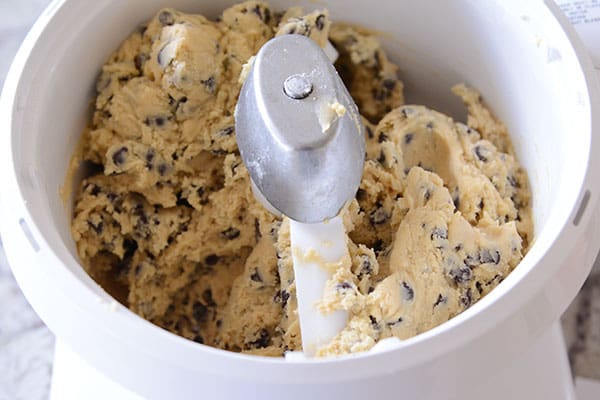
After the egg/vanilla point in cookie making, both mixers handle the cookie dough like the professionals they are.
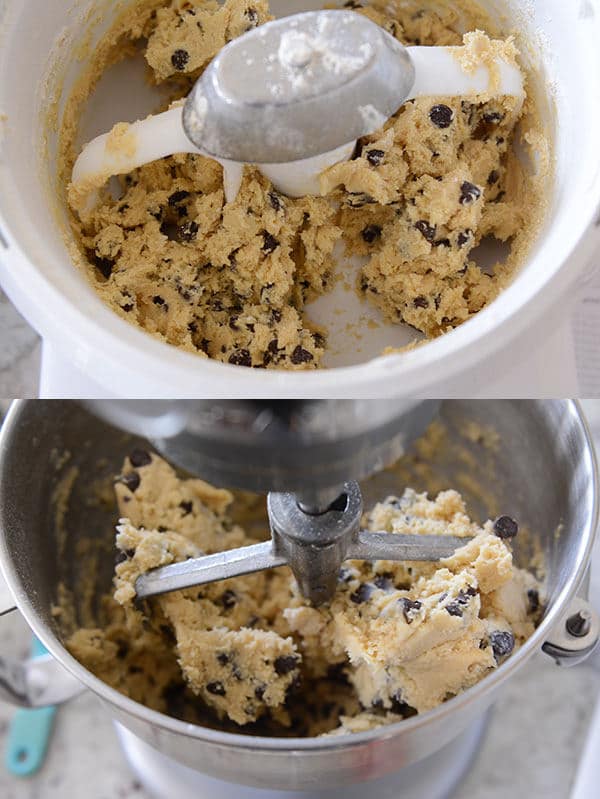
Since I already touched on it above, let’s talk about the issues of making smaller batches of recipes in each mixer.
Small Batches/Thinner Batters
No offense to my Bosch, but it stinks when making small batches of anything. Even though the description will say it can whip even one egg white to stiff peaks (and it may, I’ve never tried it), when it comes to small, or more particularly, thinner/wetter recipes, I have to do a lot of scraping, especially on the bottom of the bowl, to help incorporate the ingredients.
There IS a bowl scraper available, but I don’t have it and can’t attest to whether it helps this issue out or not, and it certainly wouldn’t help with all the goodness that gets stuck on the center shaft of the mixer and the bottom of the bowl.
The solution in the Bosch is usually to double the recipe (not always possible, I know). A batch of frosting that might need a lot of scraping usually does great when doubled.
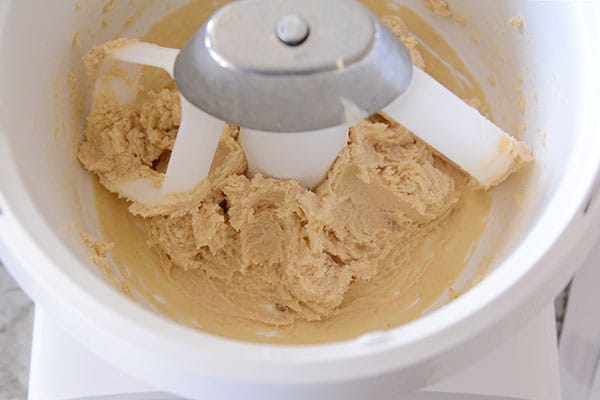
Even though the KitchenAid does require some initial scraping to get ingredients off the bottom of the bowl, it really shines when mixing wet batters, like cake recipes or frosting, or for whipping cream or egg whites.
There is also a scraper attachment for KitchenAid mixers. Again, I don’t have this, but it may be a help, although my issue with the KitchenAid is the ingredients that hang out on the bottom of the bowl even after adjusting the height of the mixer.
Despite having to still pull up ingredients from the bottom of the bowl, the KitchenAid is hands down the best mixer for standard-size recipes of thinner/wetter ingredients.
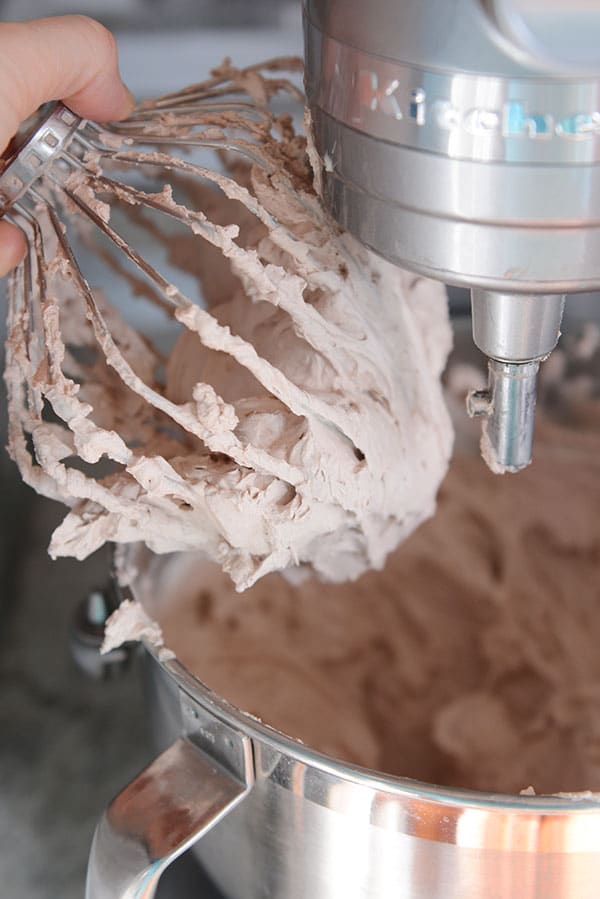
And I love having it for this perfect yellow cake recipe (although keep in mind when I made that dang recipe 17 times to get it perfect, I didn’t have a stand mixer, so my handheld mixer – more details below – did the job).
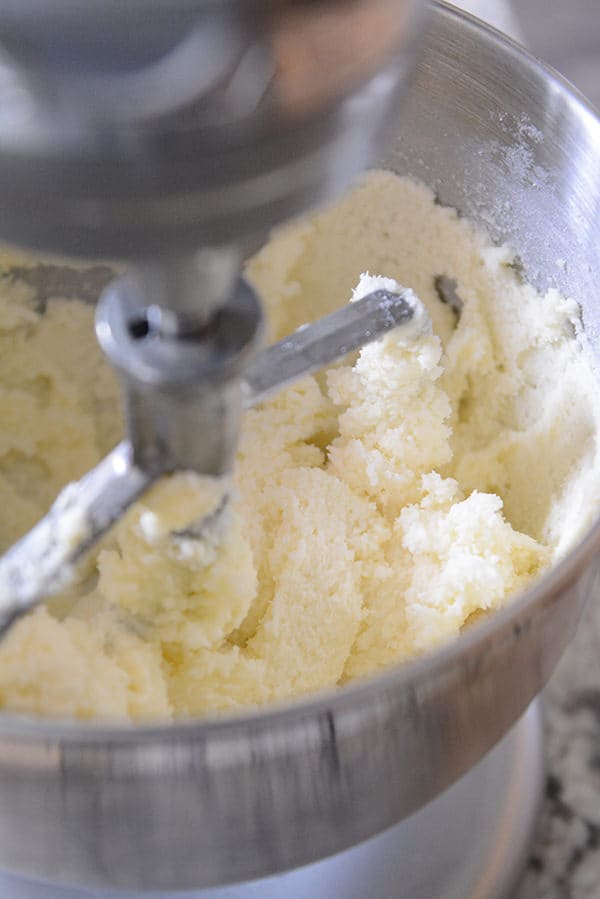
Ease of Use
I’m not going to lie, I’ve wanted to kind of scream in my pillow sometimes at trying to add ingredients to the KitchenAid while it is mixing.
My measuring cups hit the side of the mixer when adding flour and other dry ingredients; it’s hard to get all the flour added without banging the measuring cup against the side of the bowl like a madwoman to expel the last specks of flour.
If you have the flexibility to stop the mixer and lower the bowl, it’s much easier, but in small batch bread dough recipes or any recipe where you need to add ingredients gradually, it’s a pain.
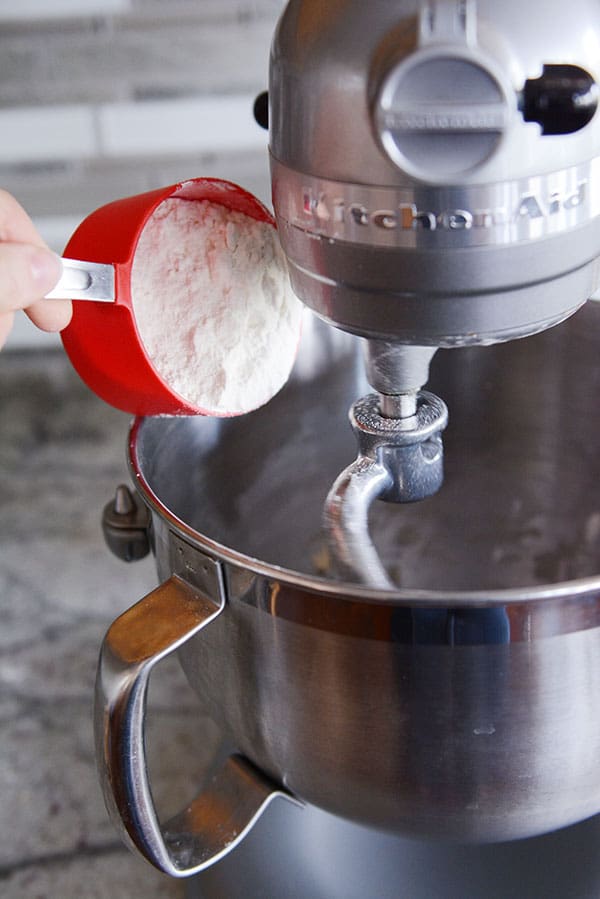
However, adding liquid/wet ingredients, like eggs or milk, seems to be much easier.
I don’t know if it’s the measuring cups I’m using or not, but clearly, adding ingredients to the KitchenAid is kind of a love/hate thing for me.
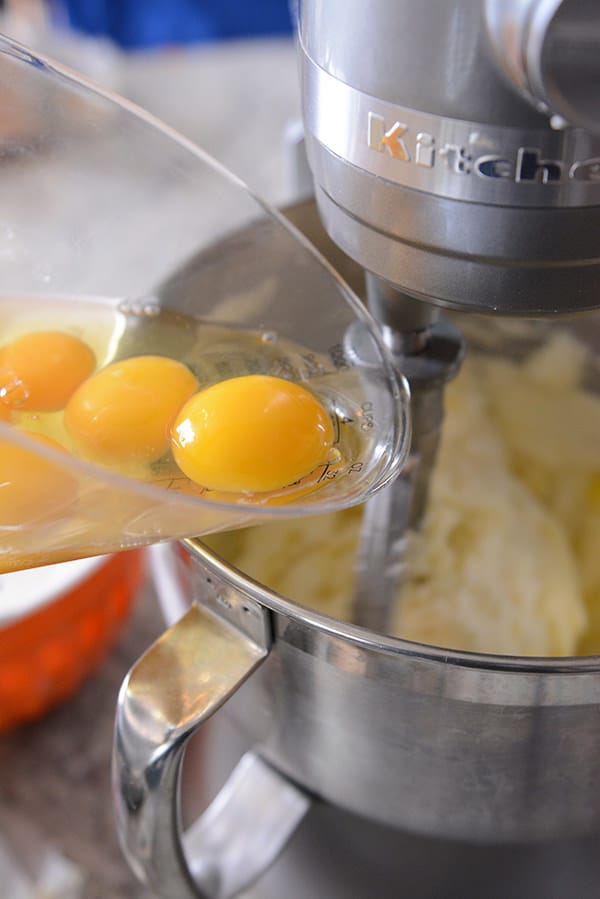
The Bosch, on the other hand, is easier for adding ingredients while the mixer is running thanks to the open top design.
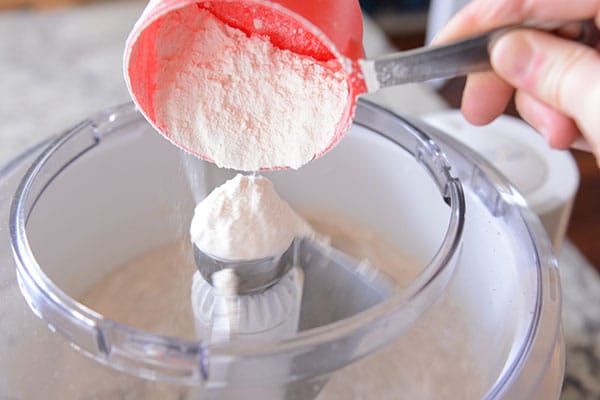
However, after adding dry ingredients, some light sweeping is usually necessary to get the excess flour (or whatever) off the metal driver.
And take care to avoid the plumes of whispy flour (or powdered sugar) that puff out of the mixer and may cause minor coughing fits (which is mainly caused by one sticking their face too close to the mixer during the dry ingredient adding procedure – not that I would ever do that).
Cookie maker beware.
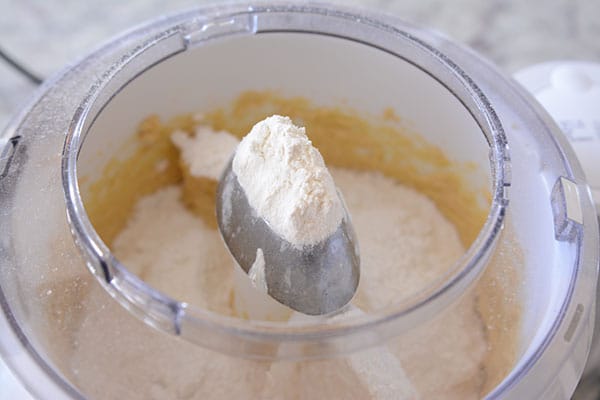
Where Does This Leave Us?
You can probably already see (if you made it this far, and if so, you deserve a cookie), that instead of proclaiming a true winner, it’s clear that each mixer has it’s strengths and weaknesses.
And much of the decision about which mixer to buy really depends on what you predominantly plan to make with it.
For serious bread makers and avid bakers of many types, the Bosch is a strong contender.
For those that see themselves making average-sized batches of cookies and cakes more than bread, the KitchenAid might be the best option.
And just to muddy the waters a bit, I have to say that in addition to my two stand mixers, I rely heavily on my everyday hand mixer, too.
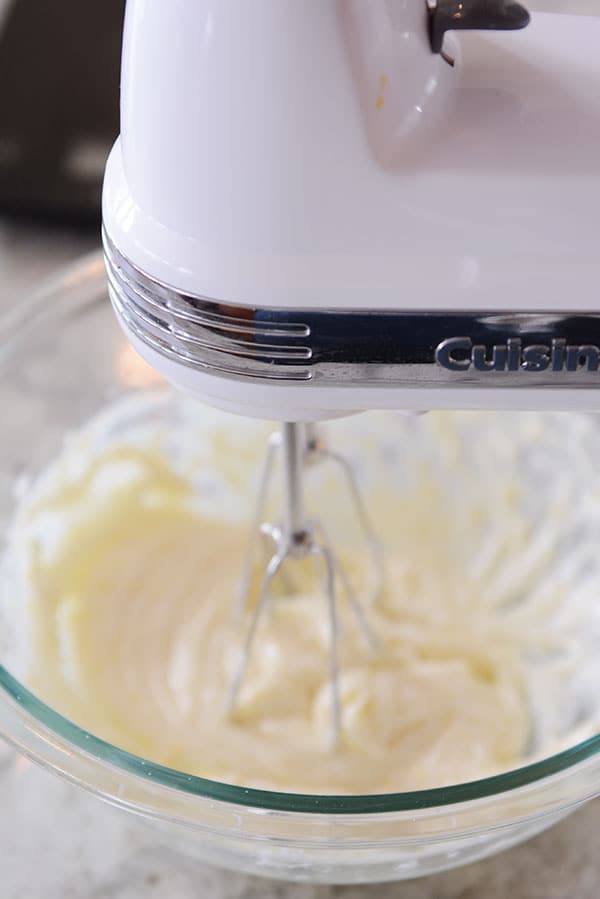
For the longest time (over a decade), it was just me, my Bosch, and my trusty hand mixer that I used to make smaller batches of frosting, thin cake batters, etc.
Maybe it’s just because I’m a creature of habit, but I like having it around.
And since I’m clearly having a good time putting together charts, here’s a recap of which mixer I use..and for what.
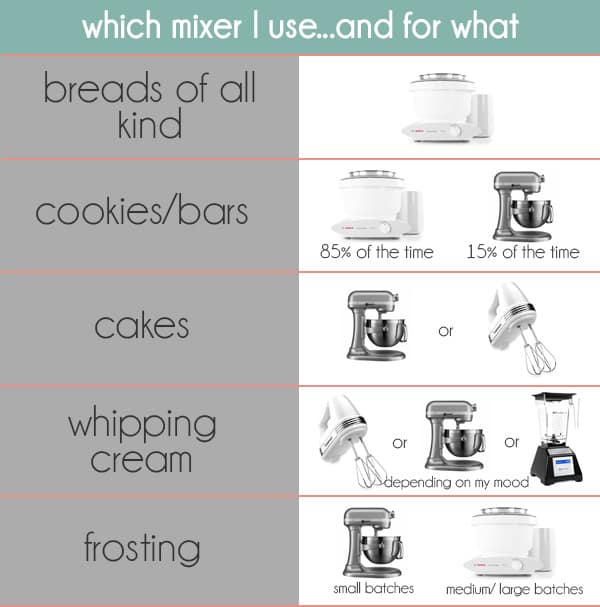
It’s probably really obvious from this post that I’m a huge fan of the almighty Bosch. I can’t help it. She’s been by my side for over a decade.
If I had to choose between mixers, I’d definitely go with a Bosch Universal.
For me, a Bosch + hand mixer (for those thinner batters) is everything I would need for day-to-day cooking and baking operations in my kitchen.
However, the lovely KitchenAid cannot be discounted in terms of all-purpose use, especially if there isn’t going to be much bread or large-batch baking.
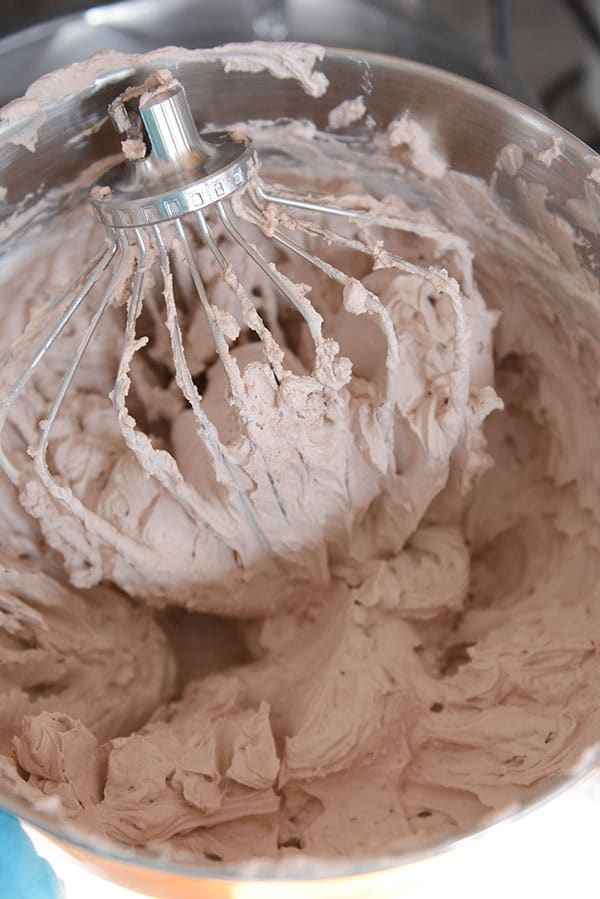
And, I will definitely say that if you are into looks, the KitchenAid has much more of an ooh-la-la factor. They are shiny and purty, no doubt about that.
The Bosch, on the other hand, isn’t fancy and doesn’t come in a million colors – it is definitely more on the humble, hard-working side of things.
And guess what? I also believe you can live your life fully and with lots of joy without even owning a stand mixer!
So, now it’s YOUR turn! If you are a stand mixer owner, which one do you have? And why do you love it?
Thanks for sticking with me for this detailed post (assuming you did, ha!). Feel free to ask any additional follow-up questions or clarification in the comments. Later, skaters!

I have been wanting a new mixer for bread making. I like be my kitchen aid but it just doesn’t cut it for the 2-3 loaves I make. This post made my day and I told Katie to tell you so
Thanks, Kristin!
I have had my 5qt. Kitchen Aid for 40 years or more and it is still going strong. The only problem I have is when making bread it tends to creep forward while kneeling so I have to keep an eye on it. I have had to replace two floors when it crawled across the counter onto the floor ad cut a hole on the linoleum and cracked the tile. The Kitchen Aid however ever stopped running.
Oh goodness! That’s not good!
Thanks for the post! I had a KitchenAid for years and switched to a Bosch for bread making and love it!! I use the wire whisk attachment for my thinner cake batters and whipped cream etc. and think it works better than the KitchenAid as well. Have you used the wire whisk attachment on the Bosch?
I have used the wire whisk attachment, but I really need to use it more. I mostly use the paddle or dough hook. Thanks for reminding me!
If you use a shield with the KitchenAid, it makes it easier to add ingredients with less mess and hassle.
My 12 year old kitchenaid just burned up on some whole wheat bread (another $1 for you) so I decided to try the Bosch since I use the mixer mostly for bread and the occasional cookies/cakes/frosting. I decided to get all the attachments and they now come with a dough hook extended for smaller batches (haven’t used it yet though) and I also got the scrapers and it worked great on whipped cream but haven’t used it for anything else yet. I will say that the scraper attachment feels pretty flimsy so I’m skeptical about its longevity. Anyway, I’ve only made bread once and it’s a learning curve, but I love getting 6 loaves at a time and I’m actually disappointed we haven’t run out of bread yet so I can try again.
I’m sorry about your KitchenAid burning up, Chelsea! Good luck learning the Bosch – I think you’ll love it.
I have a Kitchen Aid mixer. Due to limited counter space, I moved it off the counter two years ago and haven’t used it since. I make bread, never more than two loafs, and pizza weekly. I do that by hand. I also make cookies or small cakes at least weekly. I usually use a hand mixer for those, though sometimes I mix them by hand. About seven years ago I went for well over a year without any mixer and continued to bake regularly.
I think we really need to look at what kind of baking we’ll be doing before we invest in either of these mixers. My feeling is that most of us don’t need either the Bosch or the Kitchen Aid.
I agree, Sally! I think people need to think long and hard about what kind of baking they’ll be doing…maybe more could be done by hand!
I started my married life with a Sunbeam Mixmaster. It served me well for 25+ years, until the day I knocked it off the kitchen counter (I still have no idea how I did that!) while making cookies. It broke into many pieces. I still have and use the stainless bowls. I used a hand mixer or made things by hand for several years. One year for Mother’s Day my daughter bought me the Kitchen Aid. I think the biggest reason I still have it is because she was so proud of herself for being able to buy it for me without assistance from her dad or sister.
It saddens me when I see a recipe that starts with “in a stand mixer with the paddle attachment.” I think there’s going to be a generation of bakers who think you can’t bake unless you have a stand mixer.
That’s actually a valid point, Sally! I definitely don’t think you need a stand mixer but my generation has definitely become accustomed to using them. Sometimes just a bowl, spoon (or handheld mixer) is all you need. 🙂 And that’s so sweet about your daughter buying you a KA!
I have a kitchen aid. I am so proud of the hubs for getting me this for christmas (his secretary gave him the idea) that i’m in for the long haul unless the motor burns up. I make everything including small batches of bread dough. It gets used regularly for your french roll recipe. I agree about the batter sticking to the paddle, the gooey stuff getting stuck in the bottom of the bowl and the annoying action of banging the measuring cup to try to get the flour in. But I love it just the same. The one annoying feature that actually I need my husband (whose name is Mel by the way) to help with is this – when I’m making bread and have to mix it or knead it for 5 minutes or so, the vibration locks the bowl so tight onto the base that I can’t get it loose. I actually broke the handle off by torquing on it and my Mel had to solder the hole closed.
I’m glad you love it, Mariann! And kudos to your husband for listening to his secretary. 🙂
I totally agree with you on all points. I grew up using the Bosch and missed it when I went away to school and started mixing and kneading by hand.
I got married and got a Kitchen Aid as a gift. Loved it. But still my 150+ batch of cookies didn’t like the Kitchen Aid. So I would end up mixing by hand or just not making those cookies which made my husband sad.
Then I got into making dough….breads and cinnamon rolls so I took the plunge and got myself a Bosch as my own Mother’s day gift (as I hadn’t gotten one from my husband in like 5 yrs, serves him right….Right?)
Love my Bosch bit I do miss my Kitchen Aid for a few things.
Haha, yes, totally serves him right! 🙂
I bought a basic Kitchen Aid model for a great sale price .It was sent back for a new replacement a few days before the free replacement , guarantee, expired!That was over a decade ago.It did not sound or work right.
I was happy enough, after the replacement, years later to upgrade to get purchase a second one.It was then that I called the company.It did not sound the same and I was worried it would also conk out.It was eye opening to talk to customer service.They stated that the machines must be run a least once a month at a highest speed for five minutes approximately or oil will leak from the motor!( which seems to be happening with the first one!)
I find that my kitchen Aid food processor for one third the price does a better job all around!For all general kitchen jobs thought I have not tried bread mixing with it.
Great feedback!
You are most welcome.
I do find bread that is “hand made” vrs. Kitchen Aid mixer tastes different.Could be a “tighter texture ” from using a machine and less air getting in?Also it may sound “yucky” but our hands use to be how salt got into ancient bread making.Wish I could remember where I read that.
I think it was a Michael Ruhlman? book where he went to the CIA to learn more about cooking?
Hi, Mel,
I have both a Bosch and a Kitchen Aid in my kitchen. I’ve been using Bosch for 40 (!) years mixing bread with a sourdough starter that’s been alive nearly that long. I have the Kitchen Aid on long-term loan because my son moved out of United States. I agree with most of what you wrote; I do small batches of pizza dough in the Kitchen Aid (recipes sometimes utilize it and recommend times and levels). I also like some of the attachments for the Kitchen Aid, including the icecream freezer which I’ve used now for 8 years. I, too, can’t do without a hand mixer and sometimes I use an old manual eggbeater and have occasionally beaten cream with a whisk. It is nice to have options but I owe some of them to the generosity of others. If I had to choose I’d stick with the Bosch because of my sourdough bread (the starter is like one of my children).
Thanks for the detailed comment, Cole!
I had both but killed the bosch. Overflowed the blender a few times which went right into the motor and it eventually died. I only had it a few years, so I’m not a huge fan. Big waste of money imo. I even had the accessories and wasn’t a huge fan of most. I have had a kitchenaid forever. I finally broke down and got the bigger one at Costco after my bosch died. I’m not a huge fan of the larger one. I want my old one back -sticky gears and everything. It did a much better job of mixing. It just wasn’t big enough.
All that said, I have to agree. I loved my bosch for bread. Best bread mixer ever. I just can’t justify a new one for only bread. I never really preferred it for anything else. It seemed like my smaller kitchenaid did better on everything from egg whites to cookie batter. However, compared to the new, bigger kitchenaid, the bosch is sounding better and better.
I’m with you! The larger kitchen aid doesn’t work as well. It’s all about the 5qt one. As far as bosch, the parts break WAY too easily in my opinion.
Also, I hear you on the starter being like family. That’s how I feel about my kefir. 🙂
I have had both in my home for over 10 years now. I worked in a small bakery in high school where we used them both and I got so used to the strengths of each one. I think that if you bake a lot that having them both is nice. Now I want to make cookies and bread. 🙂
Haha, me, too!
My grandmother gave me a kitchenaid right before she died. I do love it but probably as much for the memories as the machine itself. Thank you for sharing this.
Memories are so powerful! Thanks, Leslee.
My Mom had her first Bosch for 25 years. She made 5 loaves of bread in it twice a week (9 kids in the family) almost for that whole time, not including batches of rolls, and whatever else she made (always in ginormous batches. It was still going strong when she upgraded to the new design. And all of us girls got a Bosch for our wedding present from our parents. You can definitely guess where we stand on this argument. 🙂
I love it!
I have had both but I do love my Bosch! I got it at Costco a couple of years ago and it came with some extras like the food processor, paddles and scraper. I haven’t had any problem with it and I do love it for bread and rolls. Thanks for your reviews on both. If friends ask I always tell them to go for the Bosch. I am a huge fan of your recipes and blog. When people ask for the recipe I just have to refer them to your blog!
Thanks, Colleen!
LOVE my Kitchenaid.. have used one for 28 years!!! . i make my bagettes in my food processor
Awesome!
I have the scraper attachment for my Kitchenaid; it was awesome for about a year. Maybe I just use it too much, or something, but I wish it was a little stiffer, because it has bent a little and isn’t quite as flush to the sides of the bowl anymore (so it doesn’t work as well). It’s more spatula, and I wish it was more spoonula, if that makes sense. I’ve had my Kitchenaid for about five years, and I totally agree with everything you have said about it! I don’t make bread enough to need another mixer right now, but once my Kitchenaid kicks the bucket, maybe I’ll look into a Bosch!
Side note: I just don’t think Kitchenaids are made like they used to be! My mom has had hers for fifteen years, my aunt’s is even older, and they’re both going strong! Mine is only five years old and it struggles sometimes!
I think a lot of people would agree with you on that, Adriana – sounds like the older model KA’s would last for decades!
I have a kitchenaid and love it.
Nice!
I never knew about the Bosch style mixer until I started reading your post Mel. For space saving, and power, I might have gone with a Bosch had I known about it before. I have a purdy Costco Kitchen Aid which I do love but I feel your pain trying to add ingredients while mixing. Also, I get annoyed when the flour sits on top of the paddle (sort of like when it’s on the middle of your driver on your Bosch). Something that people may want to consider is that there are a plethora of attachments that can be added to the Kitchen Aid (pasta roller, ice cream maker, etc) If someone was inclined to make use this more than a mixer, it may help them lean toward the Kitchen Aid. I agree with you 100%, a handheld mixer is still a must have!
https://www.kitchenaid.com/countertop-appliances/stand-mixer-attachments/
Thanks, David!
Thank you, Mel, for the informative post. I have a Kitchenaid now and I love it. But years ago I had a Bosch, and it was great, too. When the boys were growing up I made lots of bread — 8 – 10 loaves a week, and the Bosch was perfect. But now times have slowed down so the Kitchenaid has been just fine for the last 10 years.
Sorry — this seems to be a repeat of what you said, but I do want to add that I’ll need a new stand mixer soon and I’m going back to the Bosch. I make cinnamon rolls for church breakfasts and I can see large batches coming back into my life. A new Bosch will help with that. And that brings us to the fun part . . . feeding those you love. Either one of these mixers will help with that happy chore.
Loved your comment, Leslie. Thank you!
I wanted a kitchen aid right after I got married because the colors are so cute. But my husband tends to value quality over cuteness so he got me a Bosch. I’m oh so glad he did! I use it all the time. (Mine came with a Bosch hand mixer too, which is super amazing. It’ll whip cream so, so fast!). I wish it came in a cute blue and the stainless bowl came standard, but it’s a work horse for sure!
It’s hard not to be tempted by those pretty colors! I didn’t even know there was a Bosch hand mixer. That’s awesome.
Thanks for the informative and in depth comparison of these two mixers. Articles like yours are very helpful to everyone needing advice on choosing something that will be a benefit to them personally. You brought up points that some people may not think of. I have a kitchen aid mixer that I have been using for about 10 years now and I have never regretted buying it. You do have a valid point for bread dough and for that I use my bread machine anyways. For all other doughs though I have been very happy with it. What also made up my mind, was that you can buy all sorts of attachments to do other things like sausage stuffing, vegetable slicing and nut grinding, meat grinding and so on. Thanks again.
I’m glad you love your KitchenAid, Heidi! I hope the post and comment thread will be helpful to many people…I’ve learned a lot reading through the comments!
I am the proud owner of a 34 year old 8 Qt. Kitchen aid mixer with as many of the attachments (sausage, pasta, meat grinder, etc) as my husband could get one at a time for a variety of birthdays, Christmases, and Mother’s days. I find that mine works GREAT for larger batches of bread, but Costco has never carried the model I have, which is a small industrial with an ugly dark grey matte finish. Don’t care; I love it. I had a small Hobart for a while, and that was good until the worm drive broke, and tried my Cousin’s Bosch, and found it hard to manage and clean, but that may have been just the unfamiliarity factor.
Thanks for your comment, Dawn! I agree that a lot of it is what you are familiar with.
I’ve had my kitchen aid for 25 years (eek!)…I am so biased with my “first-born” that I probably shouldn’t be commenting on this post!:) I only ever make typical-sized batches of baked goods and therefore haven’t had an issue with size…I will admit (grudgingly) that doubling a bread recipe in particular wouldn’t be a good idea in my kitchen aid.
I love biased comments! Heck, I’m biased, too. Thanks for your feedback!
I have and love my Kitchenaid Artisan (325 watt, 5 qt bowl in Empire Red!). We are a small family, just my husband, me and our son, so smaller quantities are fine for us. I’ve had the mixer for about 15 years and it is going strong making a variety of things from breads to cakes to meatloaf, etc. Love the color of the mixer as well as how it works for us. I actually investigated the Bosch mixer at one point, but I decided that the Kitchenaid met our needs.
That’s awesome!
I love this. 🙂 I feel like KichenAid/Bosch discussions always get emotional – so many feelings attached to these mixers, haha. I definitely prefer my KitchenAid… but I don’t make huge batches of bread dough. Both my mother-in-law and my grandma rely heavily on their Boschs (Bosches??), so I’ve had ample opportunity to test them out – and it may be a small thing, but it drives me nuts that the bowl is not bowl-shaped, but instead doughnut-shaped. Maybe in the future once we have more kids and I’m making bigger batches of things I’ll need a mixer capable of bigger recipes, but for now I’ll stick with my KitchenAid – I’ve used it nearly daily for ten years, and still going strong. 🙂
Oh gosh, so true. Who knew that talking about mixers could cause so many emotions?? Glad you love your KA!
I have used a Bosch for years. I LOVE it…but I do wish it came in pretty colors like the Kitchenaid. It is because of the colors my daughters opted for the Kitchenaid. After seeing theirs I decided that when (IF) my Bosch ever dies 😉 , I was going with the colorful KitchenAid next.
HOWEVER! When I was visiting daughter who lives out of town I was helping in the kitchen making cookies with her Kitchenaid…I HATED the KitchenAid. I hated the big motor in my face, hated the weak sounding motor, hated the limited space to add ingredients thanks to the big motor in my face!
When visiting my other daughter I was showing her how to make bread with her KitchenAid…as I grumbled about the same things already mentioned above.
Needless to say, IF my Bosch ever dies, I will buy another (boring white;) Bosch.
I LOVE my Bosch!
Great review, Sherry – thank you!
I also got my KitchenAid at Costco 5 or 6 years ago & have been happy with it, although I wish it tilted. It was on sale for $250 & I couldn’t pass it up. I’ve never considered a Bosch mixer. And though it has decent ratings on Amazon, (4.4) I know it’s on ATK’s “Not Recommended” list. Strange how they said kneading was its downfall! Glad you like yours though.
I am a HUGE fan of ATK, but I think their reviews of mixers were/are skewed. I think they view them like someone else mentioned in this thread – that professional kitchens only use models, like the Hobart, that have a similar design to KitchenAids. I can’t imagine how kneading would be a downfall in the Bosch…it’s definitely the strong point. In this case, I don’t think they were as open minded as they should have been. Anyway, clearly I have opinions about ATK’s opinions. 🙂 Thanks for letting me share.
Very informative! Thanks Mel-
I have both the kitchen aid and Bosch. I hands down love my Bosch. My kitchen aid is loud, and I hate that! I ultimately replaced my kitchen aid with my Bosch and have never looked back.
Thanks, Misty!
I have a Kitchenaid 7qt ProLine 1.3 horsepower (don’t know the watts) and it is wonderful for making multiple loaves of whole wheat bread, big batches of cookies, etc. It is a workhorse that my smaller Kitchenaid I had before just couldn’t keep up with. I love my machine, I would purchase it all over again!
I have the same one and love it too! Also, I will add that I use the pouring shield to add ingredients while the motor is running and I have no problems. Without the pouring shield, it is a lot messier!
I echo your comments. I love my 7qt mixer! It’s currently in storage as were military overseas. I did get a 5qt KitchenAid (220 volt) at our Exchange but it’s not nearly as powerful as my 7qt–I keep thinking some breads might overpower its motor.
Sounds like the 7-quart KA has the best reviews!
The Bosch bowl scraper has a scraper for the center shaft as well as the bowl. It does not help with the bottom stuff though. I usually just scrape it by hand though.
I need to look into that scraper!
I have the Bosch and I love it. I am an avid bread maker like you, and it does a stupendous job for that. We got it for our wedding almost 13 years ago and I use it multiple times a week and I’ve seriously never had a problem with it.
Glad the Bosch has served you well, Madison!
Bosch ALL THE WAY. I’m with you Mel! Great Post.
Thanks, Emily!
This was interesting but only made me jealous. I have never had a stand mixer in all my seventy years and at the quoted prices never will. You are very blessed to have two.
I’m sorry, Nana! I do feel very blessed to have two, you are right.
I have a Kitchen Aid stand mixer, in white, that is nearly 21 years old (the 4.5 qt). It pooped out a few years ago and my hubby ordered parts to fix it. While waiting for the parts, I was wooed by Kohl’s having a deal and ordered one the next size bigger because I always wished I could make a double batch of bread. I preferred the tilt head as it seems to me the bowl lifting would be annoying (especially after only ever using a tilt head one). I was tickled when it arrived and then quickly disappointed. This wasn’t the same machine that I was used to. It did a terrible job mixing up a basic cookie dough and grating cheese with my grating attachment completely stopped the motor (my trusty old one kicks into gear to meet the demand of the load when grating cheese). I thought it was just a factory flaw so I exchanged it for a new one. Unfortunately it did the same darn thing. Upon researching, I found that the new machines aren’t made like the old ones. Mine is a Made in the USA one and is all metal inside. Thankfully my hubby fixed it and it’s working like a champ. I love it dearly and hope it lasts me the rest of my life (my mom has had hers nearly 40 years). Looks like the Bosch is amazing for mixing up bread dough, but I can’t justify that with my budget at this point. Thanks for sharing about these two mixers.
It’s definitely sounding from MANY comments like the older KitchenAids were made differently than the newer models. I’m glad your KA is working again!
I had a Kitchen Aide I liked it ok, but the motor gave out fairly soon. I now have a bosch, and I wouldn’t trade it for any other machine! Makes the BEST yeast recipes, best egg whites. It is lovely to use. I wish I had the 2nd bowl, and the little attachment to shred potatoes ect. You can get quite few different attachments to use with these machines, oh and the blenders are super!
Thanks, Tina!
I have a 12 year old kitchen aid and I love it, but I’m looking to get a Bosch when this guy hits the dust. I have a scraper paddle for my cookies and it makes ALL the difference. Creaming butter and sugar is a breeze. I do get dry stuff stuck in the bottom. But my main reason for the Bosch is I have four young boys who inhale everything I bake. Bosch will be great at making big batches.
Good point. Not sure I’d get the same use out of the Bosch without my four boys. 🙂
I have TWO Kitchen Aid mixers and love them both. I tend to be more of a sweet baker versus a savory baker, so they work great for me. Your comments about bread dough are spot-on though. I usually only make rolls during the holidays and I have to be careful as the mixer will overheat. Still, Kitchen Aid for the win!
Awesome! Lots of KitchenAid fans in this thread!
I’ve never had a Bosch but I love my 25 y/o KitchenAid! I mix everything with it! No problems with bread dough. If we ever have a major earthquake, it will be the first thing I throw in a box (after my cats, photos, and antique quilts).
Haha, I get that!
I’ve had both a kitchen aid and a Bosch and, hands down, I like the Bosch better. I could not stand adding ingredients to the kitchen aid, especially dry ingredients that always ended up going everywhere as soon as I turned on the mixer. I do wish the Bosch was better for smaller batches, but I mostly make bread so it’s not often a problem. Sounds like I need to add a good hand mixer to my kitchen tools and I’ll be all set!
Thanks, Sarah – I think a hand mixer would do the trick for you!
I have a full size Bosch and a compact version. I don’t use the full size one as often, usually when I’m making bigger batches of things. I use the compact one almost every day of the week! I couldn’t do without my Bosch! Love it!
That’s awesome the compact Bosh works so well for you!
My mom has both a Kitchen Aid and a Bosch, and she uses them both basically as you describe here. I only have a Kitchen Aid because I have a small kitchen and only have room for one mixer. I don’t have make large batches of things, so the Kitchen Aid has worked well for my needs. And I use a pouring shield to help get dry ingredients in better. It isn’t fool proof, but it does make it easier.
https://www.amazon.com/KitchenAid-KN256PS-1-Piece-Pouring-Bowl-Lift/dp/B0000CFF38/ref=sr_1_2?ie=UTF8&qid=1493066515&sr=8-2&keywords=kitchen+aid+pouring+shield
Thanks, Annette!
Great post! I have both a Bosch and KitchenAid mixers and tend to use the KitchenAid more because it stays on my counter and I feel like it is easier to wash the bowl and attachments. I will pull my Bosch out for larger batches and bread because it holds more ingredients and the motor can handle tougher jobs. I’d like to use my Bosch more but don’t want to deal with washing it – more pieces to deal with, bowl is more awkward and there are more crevices for the dough to get into.
I’m surprised at how many people have both! It’s helpful to read what everyone has to say. Thanks, Erin!
I just received my first Bosch and I have to say that I am a huge fan when it comes to making my chocolate chip cookies. It is a big recipe and my darling light pink Kitchen Aid has served we well for years but not with out LOTS of scraping towards the end to get all the flour off the bottom of the bowl. My favorite thing about the Bosch is that I can completely cover it while mixing! No more flour flying all over my kitchen when I accidentally throw the mixing switch on high when I meant to throw the locking switch into the locked position. Happens every stinking time! Obviously that is a problem with the user not the product but the Bosch protects me from myself. I will never part with my pink mixer though. It is great for cakes and frosting. Thanks for the comparison!
Thanks, Jamie!
What a great post!! I concur with all you said (I have both the Bosch and a 7 qt kitchenaid stand mixer). I will forever make bread in the Bosch..that, in my opinion, is the hands down winner. I use my kitchenaid for everything else..cakes, cookies, bars, whipping cream, pancake mix, etc. The next thing on my list is that giant stainless steel bowl for the Bosch so I can double my favorite bread recipe (the quinoa whole wheat on your blog!) have you seen that? Thanks for yet another great post and PS.. Your Curry rice is cooking away in my instantpot as we speak! 🙂
Thanks, Hilary! Yes, I have (and love!) that stainless steel bowl for the Bosch. I use it when doubling the quinoa bread…and a lot of times for my other whole wheat bread recipe. It’s awesome but definitely a bit of an investment for a bowl. 🙂
It’s the plastic bowl on the Bosch I can’t get past!!! I avoid plastic whenever I can in cooking
Understandable! It hasn’t been an issue for me over the years, but I can see the appeal of the metal bowl. I have the larger metal bowl for the Bosch, but I only use it when I double bread recipes.
I have used a kitchen aid for years and the plastic shield that comes with it allows you to add things to the mixer with ease…and I seldom make more than 2 loves of bread at a time but when I do I pefer the old hand method…even no matter the mixer or bread machine I feel the tear the dough but by hand you dont have that happening…so when using it I always take it out the last 2 minuets and need it by hand…I make it short I love my Kitchen aids. and will not change…it does a perfect job or me a cook for 40 years…
I found the plastic shield got in the way of adding the dry ingredients, too, but this is why I love getting all of your comments! So glad you love your KitchenAid!
I just replaced my wedding shower Kitchenaid with another (higher powered) Kitchenaid after 11 years of use. Which doesn’t seem nearly long enough UNTIL I read your line about bread making burning up the Kitchenaids. My original Kitchenaid started smoking when mixing up babka after many, many batches of bread over the years. I knew that’s had to be what killed it! I don’t make nearly as much bread now and I have a higher watt one so I’m hopeful this one will last longer! Also, my new one is blue and the bowl has a handle…I’m pretty heart eyed over it! Thank you for the comparison!
I bet – sounds pretty! 🙂
I have never owned a Bosch or a kitchenaid. My favorite of all is the BLENDTEC MIX & BLEND II. I had the original Blendtec from like 25 years ago and loved it. I have since upgraded to the newer one. It is probably similar to the Bosch as it can handle a lot of flour and it mixed up bread wonderfully. I’ll never have anything else.
I’ve never heard of that mixer, Monica – glad you love it!
I owned that Blendtec for many years. Loved its auto stop kneading feature, but I had a hard time with the middle staff. It cracked on me twice, and that’s when I made the switch to the Bosch. All metal parts and works perfectly. Love it!
I meant to say shaft. Lol
First comment! Whooohooo! This was very informative–thank you! We don’t have the budget for a mixer right now, but when we do, I’m definitely going to re-visit this page!
Thanks, Jaci!